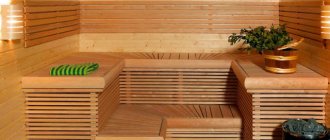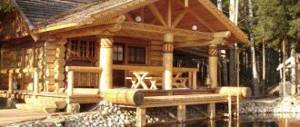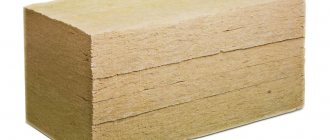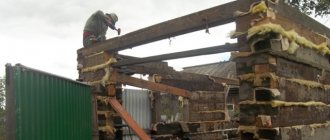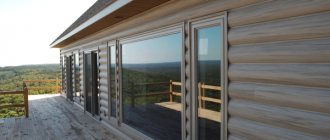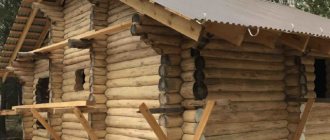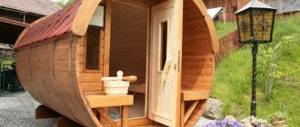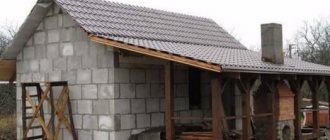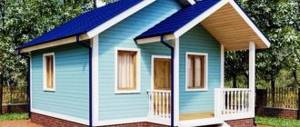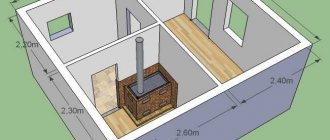External finishing materials
The finishing of the external walls of a bathhouse building does not take place without insulating the façade. Steam rooms, as a rule, are built small, so in order to avoid reducing the internal area, insulation work is carried out outside the building. In this case, the right option is a ventilated façade. Moisture does not accumulate on the walls, which increases the service life of the building.
For a ventilated facade, it is advisable to use:
- Siding. It can be vinyl or metal. Lightweight, durable material that is environmentally friendly. Weather conditions, mechanical and temperature influences do not violate the integrity of the coating. Used for cladding frame and brick buildings.
- Linings. It can be plastic or wooden. Installation is simple. Area of use: brick steam rooms.
- Eurolining. One of the types of lining is used. Very durable lumber.
- Block house. The finishing material looks like a milled log with the same thickness along its entire length. Used to imitate wood.
In addition to the main finishing options, you can sheathe a building:
- With a board. When finishing, it is customary to use edged or unedged material.
- Artificial stone. One of the long-lasting materials that can withstand atmospheric and mechanical stress.
- Baths with a solid foundation are finished with decorative plaster - “slab”. Does not require constant care, frost-resistant.
- OSB panels. The material has high strength, elasticity, does not absorb water, and can withstand high temperatures. The building does not have to be insulated.
- Facade tiles with a long service life and resistance to external influences.
Siding
There are many options for finishing baths. One of the most common methods is lining the steam room with siding.
This method is often used for buildings built of brick. It is not recommended to decorate wooden buildings with this material, since it does not provide natural ventilation of the wood. Before starting work, it is necessary to prepare siding panels, fastening parts, boards for creating sheathing, brackets, vapor barrier film, insulation material; isospan can be used as a waterproofing material. Cladding stages:
- A vapor barrier layer is attached to the outer wall, protecting the heat insulator from condensation.
- The sheathing is being assembled. 5/8 slats or boards are nailed to the wall. You need to leave a distance of 30 cm between them.
- A heat-insulating layer is laid between the profiles. There should be a gap of 1–3 cm between it and the siding.
- The insulation material is covered with a waterproofing material - isospan.
- Fifth stage. The starting strip is attached using self-tapping screws. Corner parts are mounted. Self-tapping screws can be replaced with galvanized nails.
- Siding is installed in the corner strip and starting strip.
- The panel is being assembled. The prerequisite is bottom up. All parts must fit tightly together. The assembly pattern is tongue-and-groove.
- The last bar is fixed - the finishing one. It is inserted only from the bottom.
Siding finishing
What to cover, what to finish, what to hem the ceiling in a bathhouse: advice from professionals
Well, if we’re talking about advice from professionals regarding how to decorate the ceiling in a bathhouse, then you need to give the floor to them themselves. We bring to your attention the videos that caused a completely respectful reaction from us.
Let the first video be from RusPar. Correctly, professionally, within the framework of the stated topic, you will be told how to do everything correctly:
Those who are worried about thermal protection will find this video useful, which tells a lot, in tedious detail, about what materials are suitable for protecting the ceiling and walls in the area of the stove:
Speaking about professionals, we cannot ignore the opinion of Alexey Bely, representing Teplodar. You don't have to agree, but it's still worth listening:
Well, we found a video from ForumHouse - this is a fairly authoritative forum that has been making videos about finished projects or various stages of construction work for a long time. Among them there was a video about lining - it will certainly be of interest to those of our readers who are planning to decorate the insides of their bathhouse with this material. Look, remember, maybe it will come in handy:
Well, for our part, we will consider it possible to recommend you an article about decorating a steam room, which will also contain useful information.
Lining
To preserve the appearance of a traditional Russian bathhouse, when decorating the external walls, a common cladding material is used - clapboard. Eurolining is especially in demand. This is a wooden board of small thickness. Lining has all the advantages and disadvantages characteristic of wood. To extend the service life of eurolining, it is treated with antiseptics and coated with varnish or paint.
In order for the cladding of the bath to be done correctly, it is necessary to strictly adhere to the installation technology. Step-by-step execution of all operations will allow you to carry out the cladding yourself:
- Install brackets on the wall. In this case, it is necessary to observe a step that should not exceed 50 cm. The brackets must be positioned horizontally.
- Cover the outer surface of the wall with mineral mats. For fastening, use the prepared adhesive composition. The use of dowels is acceptable.
- Attach a guide to each bracket. To check the correct location of these finishing parts, use a building level or plumb line.
- Cover the insulation with waterproofing material.
- Attach the lining to the fixed guides.
Bathhouses can be lined with clapboards with a humidity level of no more than 15%. Otherwise, after drying, unwanted gaps may appear in it.
Warm plaster
In brick saunas with a solid foundation, a mortar based on cement and sand is used for cladding. It is used less frequently in wooden structures. In this case, you need to caulk all the cracks so that there are no holes or gaps left.
Before cladding, the building is insulated. You should prepare a beam 3–5 cm in size, which will be used to create the sheathing. In addition, you will need dowels shaped like “umbrellas,” glue for polystyrene foam, polystyrene foam, a reinforcing mesh made of plastic, and a frame for creating “warm plaster.”
Installation must be carried out in strict sequence:
- Make a sheathing.
- Attach the insulation panel with dowels (strictly horizontally). When fastening, it is necessary to monitor the position of the seams. They should not be along the same line.
- Lay the second heat-insulating layer vertically. Secure it with glue capable of securing foamed polystyrene.
- Cover the structure with reinforcing mesh.
- Apply “warm plaster”.
The service life of “warm” cladding is several times longer than other cladding methods.
Installation recommendations
Not only well-chosen lighting fixtures are important when arranging a bathhouse, but also their correct installation. This issue is especially relevant for steam rooms where operating conditions are difficult. Among the main requirements for organizing lamps are:
- It is prohibited to place lamps near the stove, regardless of their degree of heat resistance;
- It is more expedient to install them on the wall opposite to it;
- you need to calculate the distance from the floor to the chandelier so as not to hit it with your head.
It is best to place lighting fixtures in the corner of the room or where the walls and ceiling intersect.
Block house
There are several types of blocks:
- natural - made from deciduous and coniferous trees;
- metal - made from galvanized steel;
- acrylic - based on polymer resin;
- vinyl - made from PVC powder.
Any type of block material is suitable for finishing. You should prepare screws and 6-7 mm clamps for fastening, mineral wool as insulation, log parts for creating sheathing, a membrane with vapor barrier properties, a waterproofing agent, antiseptic impregnation and fire retardant, which are used to pre-treat the wood elements. Cladding stages:
- Secure the vapor barrier film in a horizontal position. Secure it with staples or a construction stapler.
- Install the assembled sheathing in a horizontal position. It is attached to the wooden base with self-tapping screws and nails. It is advisable to fix it to a brick wall with dowels for frames. In the latter case, it is necessary to pre-drill the recesses.
- Lay insulation in the spaces between the beams.
- Use a stapler to secure the waterproofing material.
- Build a similar sheathing on the main frame, placing it in a vertical direction.
- Cover the outer surface with block houses. The direction of installation is from bottom to top horizontally.
- Using clamps, secure the panels.
- After completing the finishing work, hide the screw heads using sawdust paste and PVA glue. You can also use special plugs and leftover block materials.
- Place plinths in the corners. Decorate windows with slopes and doors with cash.
Blockhouse cladding
Video description
How walls are covered with metal siding is shown in the video:
In contrast, the profiled sheet is attached vertically, with the sheets simply overlapping each other along the wave relief and through fixation with self-tapping screws with a rubber washer and a painted head. Therefore, the frame under it is mounted in the form of a horizontal sheathing with a convenient step of 50-60 cm.
Scheme of wall cladding with corrugated sheeting Source iblogger-ok.ru
Wood paneling
Wood is a traditional material for finishing the facades of residential buildings and baths. It remains popular, despite the emergence of cheaper and more practical analogues - vinyl and metal siding that imitates wood paneling.
Most often, it is chosen when you need to decide how to sheathe the outside of a frame bathhouse, since it adds another warm layer to the thermal insulation pie and fits perfectly with the wooden elements of the building’s frame.
The lining material used is mainly lining, imitation timber and block house made of coniferous wood.
- Lining.
This is the most affordable type of wooden panels, which can have different profiles. The cost per square meter, depending on the species and type of wood, is from 280 rubles (pine) to 700 rubles (larch).
- Imitation of timber.
The panels are thicker than conventional lining, and their assembled profile imitates a timber frame. Sheathing with this material will cost much more - 400-500 rubles/m² (pine) with a 20 mm thickness.
Finished walls cannot be distinguished from those made of timber Source hozsektor.ru
Roof cladding
To finish the roof in a steam room, it is advisable to use corrugated sheets. This material is made from high quality galvanized sheet steel. At the production stage, each sheet is processed in roll forming machines. The corrugated sheet is protected from corrosion by a galvanized layer.
Stages of building a bathhouse roof from corrugated sheets:
- A sling system is installed.
- A sheathing is installed, which is coated with an antiseptic compound that protects the product from rotting under the influence of moist air and high temperature.
- Wooden surfaces are coated with paint that has fire retardant properties.
- Thermal insulation is being installed. This ensures protection of the corrugated sheet from sudden changes in temperature.
- A waterproofing material is placed on top of the thermal insulation, protecting the insulation from the accumulation of moisture as a result of the appearance of condensation on the inner surface of the profiled sheet. When choosing this element, you must carefully examine its structure.
Why does the ceiling drip or sweat in the bathhouse: reasons for condensation
First, a little about the nature of condensate. This is the reaction when warm air collides with a cold object. Warm air can hold more water vapor than cold air. Therefore, if the air saturated with vapor cools (and this is what happens when it collides with a cold object), then the water vapor will pass from the gaseous to the liquid phase. And this will happen at the intersection of environments.
From here it is clear that if the ceiling is dripping or sweating somewhere in the bathhouse, then this is a cold place . Basically, warm air is forced to rise because it is lighter than cold air. At the top he encounters an obstacle in the form of a ceiling. If it is cold, then moisture condenses immediately.
The bathhouse is a room with periodic heating, which means that during the time it is not used, it cools down to ambient temperature. Therefore, the occurrence of condensation should be considered inevitable.
BUT! Proper heating gradually removes the condensation that initially forms. The entire structure warms up, the moisture turns into gaseous form.
What to do? The colder the room before starting the fire, the less you should rush to warm it up . Tune in for 4 hours of light, gradual treading. Or even set aside the day before the bath procedures to thoroughly dry the bath (in the cold season).
The appearance of condensation in a bathhouse on the ceiling in the initial stage is expected, but is it correct when it does not disappear in due time? No, that's not right. This means only one thing: you have some problems with the insulation of the ceiling.
This can be anything: from the possibility that the thickness of the insulation layer is insufficient, to the fact that the rules of ventilation and thermal insulation are violated, for example, the structure of the insulating pie.
Diagram of a false ceiling pie (explanation in the article about insulation)
CHECK: vapor barrier, which does not allow water vapor to pass through, is installed first, separating the insulation from moisture coming from the room; The waterproofing is placed second and outside the insulation, closer to the “street”. A ventilation gap of several centimeters is required between the vapor barrier and the lining.
Chronic formation of condensation will not be without sad consequences - bacteria and fungi actively multiply on damp wood, the wood rots and becomes moldy.
treating wood with antiseptics everywhere except the steam room. But this will not save you from searching for the reason why the condensate does not evaporate on its own. Perhaps these are ventilation flaws. If it turns out to be insufficient, you can connect a forced one.
Front area finishing
The cladding of the front part of the steam room is made from the material used for finishing the facade. The material used in the construction of this segment of the bathhouse is also important:
- The wooden pediment can be covered with any material. First you need to install waterproofing, for which a membrane material is used.
- The concrete gable parts are pre-leveled, the sheathing is attached to them, and the sheathing is mounted. The use of molded relief elements is permitted.
Attaching the sheathing material to the pediment is done in several ways:
- Using aluminum stands. They are attached directly to the gable surface of the bathhouse building.
- If the upper front part of the facade is made of wood, the siding is attached directly to the surface.
- Using slats made from wooden materials. The elements are pre-installed on the gable part of the building.
After covering the gable and roof, drains must be installed and a sewerage system for wastewater must be installed. These measures will provide additional protection to the building.
